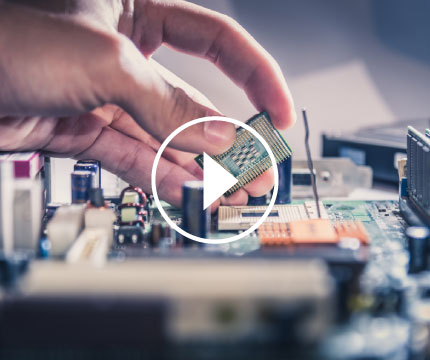Embedded Systems Training
Home > Course
Embedded Systems Training
- Course Duration: 56 Hours
- 4.6 Star (Rating)
- 3000+ (Student Enrolled till Now)
- About Course
- Demo Videos
- Course Videos
- Fee Structure
- Curriculum
- Benefits of eLearning?
- Course Instructor
About Course
InSkills Training (VG-EMBEDDED) is 5 months course to enable engineers develop skills in full breadth of InSkills starting from Advanced C, Data Structures, LPC1313 Micro controller architecture with ARM Cortex M3 processor, Linux internals and C++. Training is offered in both classroom and online training modes. InSkills Training in Bangalore is targeted towards BE, ME fresher’s and Engineers working in other domains planning to make career in InSkills domain. Course structure is framed keeping in mind the current industry requirements.
InSkills Training divided in to multiple aspects, with training focused on all aspects from InSkills basics, all industry standard micro controller architectures, Embedded C programming, standard interface protocols and multiple industry standard projects on Automotive. All these topics are covered with practical examples based on these boards.
InSkills Training course also covers multiple hands-on projects based on industry standard Automotive LPC1313 micro controller. Learning starts from developing simple board based projects to complex projects involving multiple peripherals connected to make a complex InSkill. All these projects are done from scratch. Course curriculum also ensures that student does these projects hands-on with trainer guidance as part of dedicated lab sessions.
InSkills Training also includes 30+ detailed assignments (10 in C and Data structures, 10 in Micro controllers and Peripherals, 10 in Linux Internals). These assignments are prepared by industry experts covering all aspects from InSkills. Student gets to work on these assignments with complete guidance from trainers and student learning is evaluated using completion of assignments as the sole criteria. Student is offered with multiple (more than 10+) interview opportunities based on performance in assignments. Completion of all these assignments make a fresher as good as a 3+ year experienced engineer. That’s the quality of assignments!
VLSIGuru Institute has expertise in both VLSI and InSkill domain. We have trained more than 1000 graduates over last 5 years since training was started in 2012. VLSIGuru Institute is rated among the Best Embedded Training Institutes in Bangalore .
Below is salient features of InSkills Training course.
Introduction to InSkills
C Programming on InSkills
Fundamentals of C programming
C Data structures
InSkills interfacing with peripherals
Micro controller Architecture
ARM 32-bit Micro-controller
Hands on projects
Linux Internals
C++ Programming
Demo Videos
| Unit Number | Topic | Duration (Mins) |
| 1 | Linux basics and Embedded C-data types | 194 |
| 2 | Embedded C-operators | 191 |
| 3 | Embedded C - Types of Variables, Functions and pointers | 202 |
| 4 | Embedded C - Control statements | 181 |
| 5 | Embedded C - Arrays and pointers | 176 |
| 6 | Embedded C - Data Structure | 186 |
| 7 | Embedded C - Data Structure continued | 106 |
| 8 | Embedded C - Operations using data-structures | 135 |
| 9 | Embedded C - Stack operations and Stack data structure | 157 |
| 10 | Embedded C - Recurssion and Tree data structures | 144 |
| 11 | Basic Architecture of ARM-LPC1313 | 140 |
| 12 | Basics of C-progarm for ARM-LPC1313 using keil microvision 4 software | 172 |
| 13 | Implementing Key-touch program for ARM-LPC1313 and analysing using debugger | 167 |
| 14 | Configuring ARM-LPC1313 ADC and analysing using deugger | 175 |
| 15 | Configuring ARM-LPC1313 ADC Continued ,Basics of UART and configuring ARM-LPC1313 UART | 145 |
| 16 | Configuring ARM-LPC1313 SPI , Configuring ARM-LPC1313 LCD | 144 |
| 17 | Configuring ARM-LPC1313 I2C module | 151 |
| 18 | Configuring ARM-LPC1313 Timers and counters to generate PWM and creating Task schedular , Basics of CAN Protocol | 90 |
| 19 | CAN Protocol Continued , Embedded project design flow (Ex: light monitoring system in car) | 98 |
| 20 | Configuring ARM-LPC1313 UART continued ,Bascics Serial pheripheral interface | 103 |
| 21 | Process synchronization | 143 |
| 22 | Process synchronization continued , Memory management . | 131 |
Fee Structure
Curriculum
| 1.INTRODUCTION TO C |
| Design Methods |
| Top Down Design |
| Bottom Up Design |
| Programming Languages |
| Low Level language |
| Machine Language |
| Assembly Language |
| High Level Languages |
| Structure of C Program |
| 2.Elements of C |
| C Character set |
| Alphabets |
| Digits |
| Special Characters |
| Keywords/Reserved Words |
| Data Types |
| Constants |
| Numeric Constants |
| Character Constants |
| String Constants |
| Variables |
| Variable Declaration |
| Variable Initialisation |
| 3.Operators And Expressions |
| Arithmetic Operators |
| Unary Arithmetic Operators |
| Binary Arithmetic Operators |
| Integer Arithmetic |
| Floating Point Arithmetic |
| Relational Operators |
| Logical Operators |
| AND (&&) Operator |
| OR (||) Operator |
| NOT (!) Operator |
| Sizeof Operator |
| 4.Control Statements |
| If else |
| Nesting of If else Ladder |
| Else if Ladder |
| Loops |
| While Loop |
| Do While loop |
| For loop |
| Nesting of Loops |
| Infinite Loops |
| Break statement |
| Continue Statement |
| Switch Case |
| 5.Functions |
| Advantages of Using Functions |
| Library Functions |
| User defined functions |
| Function Definition |
| Function Call |
| Return Statement |
| Function Arguments |
| Types Of Functions |
| Function with no Arguments and no Return type |
| Function with no Arguments and Return type |
| Function with Arguments and no Return type |
| Function with Arguments and Return type |
| Recursion |
| Advantages and Disadvantages of recursion |
| Local variables In recursion |
| 6.Arrays |
| One dimensional Arrays |
| Declaration Of 1-D Array |
| Accessing 1-D Array |
| Initialisation of 1-D Array |
| 1-D array and Functions |
| Two dimensional array |
| Declaration and Accessing of 2-D Array |
| Initialisation of 2-D arrays |
| Introduction to Strings |
| 7.Pointers |
| About Memory Organisation |
| Address Operator |
| Pointer Variables |
| Pointer Addresses |
| Pointer arithmetic’s |
| Pointer to Pointer |
| Pointer And 1-D array |
| Pointer and 2-d array |
| Pointers and Functions |
| Function returning Pointer |
| Array of pointers |
| Void Pointers |
| Dynamic Memory Allocation |
| malloc() |
| calloc() |
| realloc() |
| free() |
| 8.Strings |
| String constants and String Variables |
| String Library Functions |
| strlen() |
| strcpy() |
| strcmp() |
| strcat() |
| String pointers |
| Array of strings |
| 9.Structures and Unions |
| Defining a structure |
| Declaring Structure variables |
| With structure Definition |
| Using Structure Tag |
| Initialisation of Structure Variables |
| Accessing of Members of structures |
| Storage of Structures in Memory |
| Structure Bit-Fields |
| Sizeof structures |
| Array of Structures |
| Arrays within Structures |
| Pointers to Structures |
| Pointers Within Structures |
| Structures and functions |
| Self Referential structures |
| 10.C Preprocessor |
| #define |
| Macros and Macros With Arguments |
| Nesting in Macros |
| Problems with Macros |
| Macros vs Functions |
| Conditional Compilation |
| Predefined Macros |
| #pragma directive |
| 11.Operation on Bits |
| Bitwise AND(&&) |
| Bitwise OR(|) |
| Bitwise XOR(^) |
| Bitwise Right Shift(>>) |
| Bitwise Left Shift(<<) |
| One’s Compliment |
| Masking |
| Bit fields |
| 12.Storage Classes |
| auto |
| register |
| static |
| extern |
| 1.Linked list |
| Introduction to single linked list |
| Traversing a single linked list |
| Inserting an element in SLL |
| Deleting a node from SLL |
| Question on rearranging an SLL |
| Question on moving last node to front of list |
| Printing the elements of SLL using recursion |
| Recursive program to reverse an SLL |
| Doubly linked list |
| Circular linked list |
| Problems on DLL and CLL |
| 2. Stacks and Queues |
| Introduction to stacks |
| Implementing of stacks using arrays |
| Linked list implementation of stack |
| Implementing of queue using arrays |
| Implementing of queue using Linked list |
| Implementation of queue using circular array |
| Infix to postfix conversion algorithm |
| Postfix evaluation algorithm |
| Problems on Stacks and queues |
| 3.Trees |
| Introduction to tree traversals |
| Implementation of traversals and time and space analysis |
| Double order traversal |
| Triple order traversal |
| Number of binary tress possible |
| Recursive program to count number of leaves and non leaves |
| Recursive program to find the height of tree |
| Binary search Tree |
| Problems on BST |
| 1.Introduction to ARM Cortex m3 |
| 2.Introduction to LPC 1313 |
| 3.Memory Architecture |
| 4.GPIO Handling |
| Configuring General Purpose Input and Output Module |
| Switching the Peripherals (on / off) |
| Signaling LED’s |
| Monitoring the User Keys…etc |
| LED Blinking |
| 5.Analog Joystick |
| 6.Analog touch Sensor |
| 7.Analog Encoder |
| 8.Seven Segment Display |
| 9.LCD |
| 10.ADC |
| Implementation of Analog to Digital Converter |
| Observing LM35(Temperature) |
| Analog Voltage Measurement (POT) |
| Finding Analog Joystick Positions |
| 11.DA |
| 12.PWM |
| Implementation of Pulse Width Modulation |
| Motor Speed Control |
| Light Intensity Control |
| Buzzer Sound Control |
| 13.Timers |
| Implementation of Timers |
| We Can Implement Task Scheduler |
| For Counting Events |
| For Encoder Pulses |
| 14.Systic timer |
| 15.NVIC |
| 16.Interrupts |
| 17.UART |
| Implementation of Universal Asynchronous Receiver and Transmitter |
| See the Controller data at live time in another Screen |
| Send Instructions to Machine when it is running |
| Perform Simplex communication |
| 18.I2C |
| Implementation of Inter Integrated Circuit |
| Transmitting the Data from Master to Outside Slave |
| Saving the Live Data in EEPROM |
| Handling Real Time Clock |
| 19.SPI |
| Implementation of Serial Peripheral Interface |
| Processor to Processor Communication |
| Handling DAC with SPI |
| Sending data to MAX7219(4 digit SSD) |
| 20.CAN |
| Elaboration of Control Area Network |
| Real time data Transmission |
| Data Security |
| Filtering data |
| Error Handling |
| 21.Cooperative task Scheduler |
| Implementation of Co-operative Task Scheduler |
| Periodic Execution of tasks |
| 22.Real Time Projects |
| Project1 : Setting Factory Defaults |
| Usage: Fix vehicles speed limit, rpm, engine Temperature etc. |
| Project2 : Smart Home Automation |
| Usage: You can able to Set any electronic device when to ON and When to OFF or Automatically sensing etc. |
| 23.Interview Point of Questions |
| NOTE:All Implementations are from Scratch(by seeing controller User Manual) |
| 1. Operating System |
| What is an operating system |
| Why Linux? |
| Linux Kernel Architecture |
| 2. The Process |
| Process State |
| Process Control Block |
| Context Switch |
| CPU scheduler |
| Dispatcher |
| 3. Scheduling Algorithms |
| FIFO Scheduling Algorithm |
| Round robin |
| Priority Based Scheduling |
| Shortest Job First |
| 4. Processes |
| Creating Sub process with fork |
| Synchronising With the Creator process |
| System commands |
| The Process Table |
| Orphan and Zombie Process |
| 5. Threads |
| 6. Signals |
| 7. The Operating System Interface |
| What are System Calls? |
| System call Interface |
| 8.Inter-Process Communication |
| Pipes |
| What is Pipe? |
| Parent and Child Processes |
| Reading closed Pipes |
| FIFO |
| Accessing a FIFO |
| Client/Server Using FIFO |
| 9. Process Synchronisation |
| Need of Synchronisation |
| Introduction to Synchronisation Mechanisms |
| Conditions for Synchronisation Mechanisms |
| Lock Variables |
| TSL |
| TSL Question |
| Disabling Interrupts |
| Turn Variable or Strict Alteration Method |
| interested Variable |
| Peterson Solution |
| Tracing Peterson Solution |
| Sleep and Wake |
| 10. Introduction to Semaphores |
| Counting Semaphores |
| Problems on Counting Semaphore |
| Binary Semaphore or mutexes |
| 11. Threads |
| Introduction |
| Threads Creation |
| Thread Termination |
| Thread Synchronization |
| Mutexes |
| Semaphores |
| Reentrancy |
| 12.Inter Process Communication |
| Message Queues |
| msgget |
| msgsnd |
| msgrcv |
| msgctl |
| Shared Memory segment |
| shmget |
| shmat |
| shmdt |
| shmctl |
| Semaphores |
| Semaphore Definition |
| Linux semaphore Facilities |
| Using Semaphore |
| 13. Memory Management |
| Memory Hierarchy |
| Virtual memory |
| Fragmentation and Compaction |
| Dealing with Fragmentation |
| Page Table in Memory |
| Memory allocation with Paging |
| Sharing the processor and sharing Memory |
| Swapping |
| Page Tables |
| Levels of page Table |
| Page Table Hierarchy |
| Page Tables problem |
| Page Replacement |
| Page Replacement Algorithms |
| Virtual to Physical address translation |
| Two level Translation |
| Three level Translation |
| 14. DeadLocks |
| What is Deadlock? |
| Why Deadlock is a problem? |
| Conditions for Deadlock to Occur |
| How to deal with Deadlock |
| Deadlock Prevention |
| Deadlock Avoidance |
| Deadlock Recovery |
| Deadlock Handling Mechanisms |
| Bankers Algorithm |
| Resource allocation Graph |
| 1. Introduction |
| Why C++ |
| Difference Between C and C ++ |
| Procedural Oriented Programming Language |
| Object Oriented Programming Language |
| 2.What is C++ |
| Features of C++ |
| Data Encapsulation |
| Data Abstraction |
| Polymorphism |
| Inheritance |
| 3. Basic Input Output Statements in C++ |
| The standard output stream(cout) |
| C++ program Structure |
| Compiling and Executing C++ Program |
| Namespaces |
| New Datatypes in C++ |
| 4. Scope Resolution Operator |
| Syntax of Scope resolution operator |
| References |
| C++ References vs Pointers |
| C++ pointers vs References |
| 5. Function Overloading |
| What is function Overloading |
| Default Values in parameters |
| Argument passed by value and reference |
| Inline functions |
| What is Inline function? |
| Reason for the need of Inline Function |
| Difference between Inline functions and Macros |
| Advantages of Inline functions |
| 6. Class |
| What is Class? |
| Features of Class? |
| How to Write a Class? |
| Access Specifiers |
| Creation of Objects |
| Data Encapsulation Example |
| Malloc and New |
| 7. Friend Classes |
| Friend functions |
| Friend Classes |
| Class Member Functions and Classes as Friends |
| Friend Declarations |
| 8. Constructors |
| Types of Constructors |
| Default Constructor |
| Parameterized Constructor |
| Copy Constructor |
| Destructor |
| 9. Operator Overloading |
| Operator overloading Restrictions |
| Operator overloading of Different Unary and Binary Operators |
| 10. Inheritance |
| Inheritances Between classes |
| Types of Inheritance |
| Single Inheritance |
| Multiple Inheritance |
| Multi Level Inheritance |
| Hybrid Inheritance |
| Hierarchical Inheritance |
| 11. Polymorphism |
| Pointers to Base class |
| Abstract base classes |
| 12. Templates |
| Function Templates |
| Class Templates |
| Advantages of templates |
| 13. Exception Handling |
| Exceptional Behaviour |
| Facing an Exception |
| Catching Multiple Exceptions |
| Nesting Exceptions |
| Group discussions will be running throughout the course |
Benefits of eLearning?
- Access to the Instructor - Ask questions to the Instructor who taught the course
- Available 24/7 - VLSIGuru eLearning courses are available when and where you need them
- Learn at Your Pace - VLSIGuru eLearning courses are self-paced, so you can proceed when you're ready
Course Instructor
- Dedicated Trainer Accessible On Phone / Email / Whatsapp
- Trainer Exp: 15 Years

Price - ₹35,000 + GST
₹44,000 (20% Off)
10 hours left to avail at this price
Course Highlights
- 1-1 mentor support
- Mentor guidance support for assignments
- Multiple mock interviews
- Dedicated live support sessions over weekends
TESTIMONIALS
What Our Students Says About Inskill

I enrolled in Frontend Verification training course, firstly about the syllabus, they teach a lot of things I have compared to other classes no-one teaches so many things as VLSIGURU has taught me. The live lectures happen on regular basis which is a combination of theory as well as practicals. The mentors are just awesome they have a very good knowledge about the modules and clear our every doubts.
The admins are very much co-operative and understandable and help you throughout the course.
The concepts taught are in a very simplified manner and every lecture is recorded.
Very much satisfied will recommend to any VLSI enthusiast

I have done functional verification for fresher and being professor at University i am looking for good syllabus content as well as complete project guidence. I am very much satisfied with both of these. Their syllabus cover entire verification cycle. I always get support for all my queries, i used to ask my problems or errors directly to Shrinivas sir and his response not only solve my queries but also boost my confidence. sometimes we used to ask very simple and silly things but he is very polite and humble, in fact for course with 6-7
jagrat mehta
months duration you need constant motivation and inspiration, take regular feedback and help us to crack interview. Weekend Lab session are very useful for candidates who used to work during week days. Placement support is very important and i am very proud (not egoistic) to say i havr been selected in 4 companies and even Shrinivas sir help me how to select among these companies based on my priorities and requirements. Thank you very much to Shrinivas Sir and Team.

To start up career in VLSI domain,
Inskill is best Platform with both Offline and Online flexibility.
Trainers and Mentors having wonderful teaching style where they clear the concepts and doubts from basics. Also, got placement support from institute. Study materials provided to us are well structured.
Thank you so much to Trainers , Mentors and Admins who supports me a lot. Once again,
I thank VLSI guru training institute for helping me to start my career in VLSI Domain.
Harish kumar
Best place to start your career in vlsi domain.
They act as bridge to help students to get industry requirements for the job.
Interms of teaching they are excellent for what we paid and get less fees compared to other institutions.
Even after course completion also they support if u had any doubts.

Faculties are well experienced and very helpful.
I joined the online weekend classes but all my doubts and concepts were cleared by faculty members.
They even provide extra time if needed to assist you.
FAQ
- Course presentations for all topics
- Session notes
- Lab documents with detailed steps
- User guides
- Exposure to C Language programming
- Exposure to any processor architecture
- Exposure to some standard interface protocols like I2C, SPI, GPIO etc
- Above all is good to know, however trainer will start from basic concepts without any assumptions on student exposure to above topics
- Course will cover multiple Hands on Embedded Systems Projects based onRaspberry Pi & PIC Microcontroller. These projects are integrated in to eachsession of course giving practical overview of each aspect learnt.
- Ex: While learning Interface protocols like GPIO, SPI, I2C, we will use Raspbery Piboard to teach how these protocol communication work on board.
- Course has been framed by industry veteran(Girish Kumar) with 16+ years of industry experience
- Course will be completely executed by Girish Kumar(Previously manager with Cisco Systems)
- Embedded systems training course is offered both classroom and through online
- Online sessions will be done using gotomeeting.com
- Student has option to attend a demo session(for both class room & online) before registering for course
- Each session of course is recorded, missed session videos will be shared
- Yes, You will have option to view the recorded videos of course for the sessions missed
- You will have option to repeat the course any time in next 1 year
- Yes, Course fee also includes support for doubt clarification sessions even after course completion
- Student has option to mail queries or clarify doubts in person
